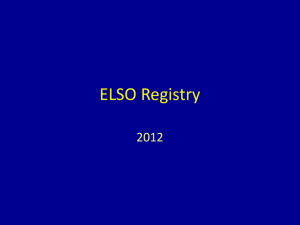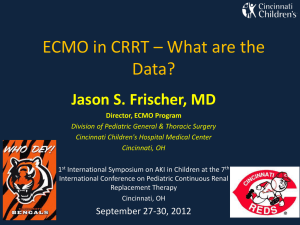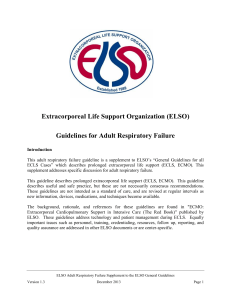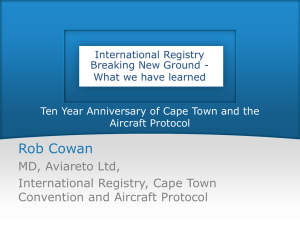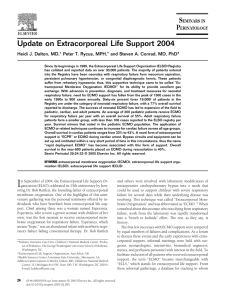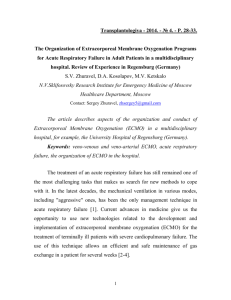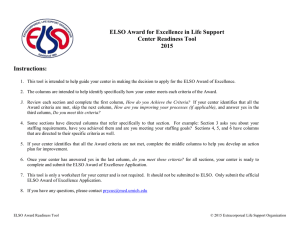Update on ECMO in paediatric patients
advertisement
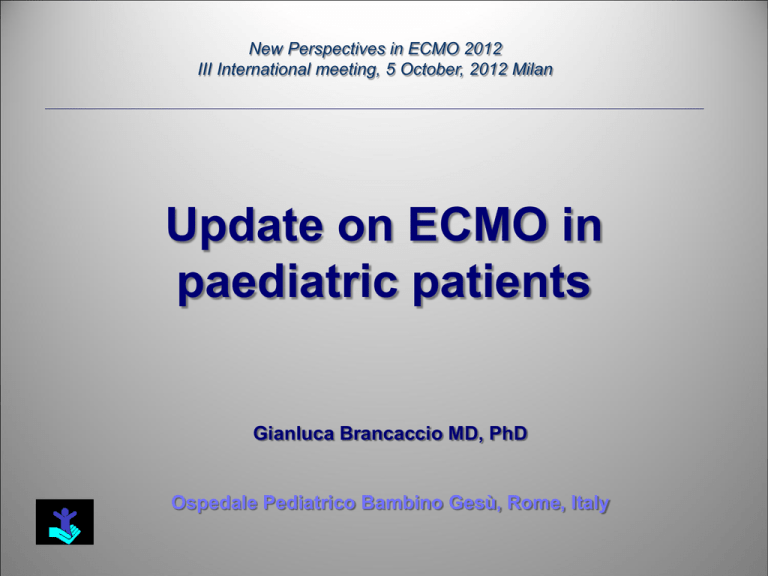
New Perspectives in ECMO 2012 III International meeting, 5 October, 2012 Milan Update on ECMO in paediatric patients Gianluca Brancaccio MD, PhD Ospedale Pediatrico Bambino Gesù, Rome, Italy Background • ECLS is constantly improving since it was first used in critically ill patients with respiratory failure over 40 years ago. • To date over 50.000 patients were treated with ECMO, been neonates and infants the majority. • Aim of this overview is to illustrate the changing in environment, equipment and management in ECLS over time. Runs by Year 100% Card (16 years and over) 80% Card (1 year < 16 years) Card (31 days < 1 year) Card (0 - 30 days) 60% Adult Pulm Ped Pulm Neo Pulm 40% 20% 0% ELSO Registry July 2012 Neonatal Respiratory Cases Clark RH et al. N Engl J Med 342: 469-474, 2000 ELSO Registry July 2012 Cumulative Survival in Neonatal Respiratory Support ELSO Registry July 2012 Neonatal Cases by Year and Diagnosis ELSO Registry July 2012 Neonatal Diagnoses and Survival ELSO Registry July 2012 Initial Mode of Neonatal Respiratory Support ELSO Registry July 2012 Pediatric Respiratory Cases ELSO Registry July 2012 Pediatric Cases by Year and Diagnosis ELSO Registry July 2012 Initial Mode of Pediatric Respiratory Support ELSO Registry July 2012 Cardiac ECLS by Diagnosis 0 – 30 days old Runs % Survived 4,361 38 Cardiac Arrest 77 26 Cardiogenic Shock 72 40 116 61 57 49 440 43 Congenital Defect Myocardiopathy Myocarditis Other ELSO Registry July 2012 Cardiac Cases By Year 0 – 30 days old ELSO Registry July 2012 Cumulative Survival in Cardiac Support 0 – 30 days old ELSO Registry July 2012 Cardiac Cases By Year Under 16 years ELSO Registry July 2012 Cumulative Survival in Cardiac Support Under 16 years of age ELSO Registry July 2012 Cardiac Survival by Diagnosis and Year Under 16 years ELSO Registry July 2012 HOW HAS ECLS EQUIPMENT CHANGED • Tubings heparin-bounded • Pumps – Roller pump – Centrifugal pump • Cannulae (Avalon) • Plastic oxygenators – Silicone membrane oxygenators – Hollow-fiber membrane oxygenator (HFMO) Avalon Elite™ Bi-Caval Dual Lumen - Triple lumen cannula - ↓ recirculation - Good flow dynamics - Sizes from 13 Fr to 31 Fr. Conclusions • The field of ECMO is currently in a state of flux. Many patients denied ECMO support in the past are now being considered for ECMO support and obtaining long-term survival. • The experience and knowledge gained over the past 20 years or more of ECMO has resulted in making this therapy more accessible, safer, and efficient. • The revised interest in use of ECMO in cardiac arrest, sepsis and other populations may herald an increase in the use of ECLS in future days. Experience OPBG • A total of 93 venoarterial ECMOs were delivered to 90 patients: in 3 cases two separate ECMO sessions were necessary; 3 patients were bridged from ECMO to ventricular assist device ECMO patients (n. per year) 2006 2010 2007 2011 2008 2012 2009 30 20 16 8 17 14 6 ECMO indications • low cardiac output syndrome (LCOS) in 10 cases • post-operative LCOS in 61 patients • respiratory support in 20 children • sepsis in 2 patients nsLC OS 11% sepsis 2% resp suppo rt 21% surg LCO S 66% Results • Children who survived on ECMO had a significantly shorter treatment duration: 4 (2.7-7) vs. 9 (5.7-16) days p<0.0001 Results-2 • Age, weight, RACHS score, indication to treatment, pump type, cannulation site, need for renal replacement therapy and the presence of univentricular anatomy were not significantly associated with an increased ICU mortality (p>0.05). ECMO patients and UVH survived 13 7 y dead 37 33 n Overall Patient Outcomes Total Neonatal Respiratory Cardiac ECPR Pediatric Respiratory Cardiac ECPR Adult Respiratory Cardiac ECPR Total Surv ECLS Surv to DC 25,746 21,765 85% 4,797 2,928 61% 784 496 63% 19,232 75% 1,912 40% 304 39% 5,457 5,976 1,562 3,556 65% 3,855 65% 843 54% 3,061 56% 2,913 49% 630 40% 3,280 2,312 753 2,094 64% 1,243 54% 276 37% 1,808 55% 891 39% 207 27% 50,667 37,056 73% 30,958 61% ELSO Registry July 2012 Cannulation • Central vs. peripheral cannulation – Jugular-carotid – Femoro-femoral VA ECMO – Femoro-femoral VV ECMO • Veno-venous vs. veno-arterial ECMO • Percutaneous cannulation Results-3 • However, a trend to increased mortality was evident in RRT patients. Furthermore, in our patients, respiratory ECMOs showed a better chance to be weaned off than cardiac ECMOs (75% vs 43%, OR 3.8, 95% C.I. 1.7-11, p:0.01). However, ICU survival was not significantly different (55% vs 40%, OR 1.9, 95% C.I. 0.7-5.3, p:0.2). survived 13 7 y dead 37 33 n

